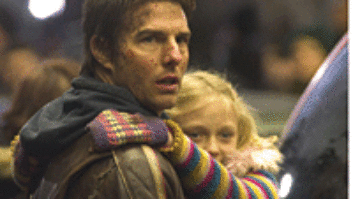
THE EPIC sea adventure is as old as film itself, spanning from thesilent years up through various remakes of Treasure Island andMutiny on the Bounty, the unforgivable turkey CutthroatIsland and last summer’s surprise smash hit, Pirates of theCaribbean. But there’s something remarkably fresh and differentabout Peter Weir’s latest film, Master and Commander: The Far Sideof the World, which is adapted from Patrick O’Brian’s belovedseries of books and stars Russell Crowe in his first major role sinceA Beautiful Mind.
Yes, the film contains the requisite cannon battles, gruff lads,claustrophobic quarters, a savage storm at sea and a good, bloodyflogging. But Weir’s take on the genre also steers clear of many of theclichés, while providing a realistic, almost documentary approachto life at sea, the cruelty of ship battles, and the courage andcompulsions of explorers, mercenaries and seamen of every stripe. Fromthe opening shot to the film’s conclusion, there’s barely any timespent on terra firma: You can be forgiven if you don’t have yourland legs after two-plus hours aboard the HMS Surprise. It’s a hard,harrowing voyage.
Weir is an imaginative storytellerand a master character portraitist, with a diverse body of work that isalive with humanity and passion, as witnessed by such gripping films asGallipoli, The Year of Living Dangerously, The Truman Show, Witness,Fearless and The Mosquito Coast (as well as the charmingcomedy Green Card). All of those films share at least one thingin common: They are about outsiders, literally or figuratively, andMaster and Commander fits neatly into that oeuvre. The maincharacter, Captain Jack Aubrey, is a classic sea hero, comfortable onthe ocean, awkward in port, truly only himself when he’s at the helm ofhis ship. Clearly, that facet of the Aubrey character resonated withthe Australian director, who says he was sufficiently captivated by theO’Brian Master and Commander series (all 20 books!) to looselyadapt books one and 10 to create this film.

On the early October day I visited the John Ford Theater on the Foxlot in Los Angeles, Weir and the post team are tweaking the final mixfor reel 6, a climactic battle scene involving the Surprise and itsFrench nemesis, the Acheron. (This takes place during the Napoleonicwars at the beginning of the 19th century.) It’s a stunning actionsequence, with lines of cannons aboard the two ships firing broadsidesat each other at extremely close range; their ordnance screaming andwhizzing through acrid, obfuscating smoke, smashing (withsubwoofer-rattling force) into decks and masts; and sending a hail ofsplinters, shrapnel and bodies flying. Musket fire and the shouts andscreams of the crews add to the overwhelming chaos. There is a momentof near silence, where the firing has stopped and the damage aboardeach vessel is no doubt being assessed, and then comes the chillingcraaaaaack of the Acheron’s mast. In a long shot through hazy,swirling smoke worthy of a J.M.W. Turner painting, we see the Frenchship’s mighty main mast toppling sideways into the water as the Britishsailors cheer. This surely signals the beginning of the end for theAcheron, though much more is in store for the crew of the Surprise whenAubrey leads a boarding of the crippled ship.
Across the length of the Ford stage’s huge Neve DFC console,re-recording mixers Paul Massey (dialog, music) and Doug Hemphill(effects) make minute adjustments to the scene, occasionally consultingwith supervising sound editor Richard King, who roams the stage andcuts sweeteners from his Pro Tools rig at the back of the room; musiceditor Simon Leadley, who sits at Massey’s left at a Pro Tools station;ADR editor R.J. (Bob) Kizer, whose Pro Tools rig is behind the console;and picture editor Lee Smith, a one-time sound designer who knows everyframe of the film and also knows director Weir’s inclinations on mosttechnical matters: This is his eighth film with the director, and theyclearly have the sort of intuitive telepathy that comes in the bestdirector-editor relationships.
Weir drifts in and out of the room, listening attentively to theadjustments and making suggestions. At one point, he asks if there is away to bridge the gap between the last cannon shot of the battle scenewith the subtle music cue that foreshadows the imminent collapse of themast. Hemphill brings in some ominous, almost inaudible LF rumble andthat seems to do the trick. Then, Weir thinks the celebration of theBritish troops after the mast falls sounds “toocontrolled,” so Kizer is called upon to provide some wilder crowdelements from his vast storehouse of ADR and production sound elements.He finds a lusty, celebratory “huzzah!” and Massey artfullyblends it in with the existing track.

There is an easy camaraderie among these consummate professionals,and the hard work is peppered with lighthearted joking and, in keepingwith the spirit of the film, unending nautical references and puns.Weir seems to be as popular with his crew as Aubrey is with his —to a man, the mixers and editors speak admiringly of Weir, and he, inturn, has the utmost confidence and respect for his post soundteam.
During a break in the action, Weir and I retire to his office offthe Ford stage to talk about his sonic approach to the film: “Iwanted to do something a little different with this dusty genre, whichhasn’t really been touched much in recent years other than Piratesof the Caribbean, though that belongs in the branch of sea filmsthat is more on the fantasy, less realistic side,” Weir says.“To do something like this film, which is true to the detail, youprobably have to go back to something like Das Boot, which was quiteinspirational, though not particularly relevant, of course. I wanted itto have its own unique sound. I also wanted the music to be usedsparingly so the audiences’ ears would have lots of time to adjust tothe sounds of the ship. If you put music from one end of it to another— and that would be an easy thing to do — you wouldn’t getto know the sounds of the ship.”
How did Weir form his own views on shipboard sounds? Is he a sailor?“No, I’m not a sailor, but before I made this film, I took twocruises on the Endeavor, which is probably the most accurate re-createdvessel there is from this period: the 1770s. It was Captain Cook’svessel. I spent three days on one voyage, four on another, and you workthe ship. It’s not just museum-accurate on the top; it’s also accuratebelow, so you sleep in hammocks and everything is as it would have beenin the time of Cook. What I learned on those trips became thefoundation for everything I did from then on — the script throughto the shoot, to the post — and I made extensive notes about thesounds I heard. Everything was always moving, including the timbers ofthe vessel. A lot of times, you couldn’t even identify what the soundswere; you couldn’t determine what was rubbing against what. But there’salmost always this great creaking and groaning and noises ofindeterminate origin.
“Then, out on the top deck, you’ve got all of the sounds ofthe rigging and the sails and, of course, the water. I’m fortunate inthat Richard King is a sailor, as are Paul [Massey] and Doug[Hemphill], so they’re particularly sympathetic to the sounds of thesea. I really wanted this to be a sea film. It opens at sea and ends atsea, and there’s no architecture in it at all or the usual frames ofreferences to settle into: the barrel on the quay, the carriage pullingup, the crinolines of the young lady saying goodbye to her officer. Ididn’t want any of that. I wanted the viewer to have the uniqueexperience of joining the voyage and really being a part of it, becausethat was my favorite experience of reading O’Brian. I loved the booksthat dealt with the longer voyages because you got lost in them more.That’s what I was after: the feeling of being at sea.”
Principal photography took place over a five-month period inEnsenada, Mexico, using the same mammoth sea “tank” thatJames Cameron employed for Titanic, except this time around,there was a full-size working replica ship, the Rose (which became theSurprise), as well as another ship on a gimbal and other portions ofships on gimbals on soundstages. Weir is a stickler for authenticity,and he had a series of notebooks filled with pertinent information forvarious crew members. “He had one pertaining to sailing, anotherto armaments, all different subjects,” says King. For ADR editorKizer, the loose-leaf binder included a list of cannon commands, anEnglish-French sailing dictionary, charts on sabre combat, historicalbackground on the period of the film, and a 26-page glossary so he’dnever mix up a “clew” with a “leech” or a“luff.” Even the right-hand wall of the Ford Theater wasadorned with a giant schematic of the deck and interior of theSurprise.
Only a portion of the production sound from the shoot was usable,says Kizer, “because you have scenes like the storm sequencewhere they’re using giant engines to get the wind and water going.Another problem is that everybody had radio mics, but they didn’trespond that well to humidity or water, so sometimes you only got halfof the words, and even then you could only hear one or two over thedin.” Well over half of the dialog had to be looped later atstudio sessions in London, Vancouver and, in Russell Crowe’s case,Australia. “A lot of it was group ADR,” Kizer says.“We had these loop groups of 12 in England, and we’d have themchoking each other and fighting to get the mayhem we needed.” Itwas also a very Foley-intensive film, with Gary Hecker supervising thataspect — which also included considerable swordplay — overat Sony in L.A.
When it came to effects, Weir wanted realism over Hollywood bombast,noting, “Fortunately, O’Brian is very detailed in hisdescriptions of the sounds of the ships and the battles, and, ofcourse, there are some re-created vessels. So we had a good startingplace, but then Richard [King] went to some extraordinarylengths,” he says with a laugh.
ORIGINAL EFFECTS RECORDING
Indeed. King and effects recordists Eric Potter and John Fasalventured far and wide to capture authentic sounds for the film. Oneexcursion found them in the snows of Michigan in January recordingcannon fire on Zaxcom Deva 24-bit 4-channel recorders, stereo Nagra andDATs (see “Fun With Cannons” sidebar). Muskets and otherguns required a whole other recording environment.
“We did several musket sessions in this small but containedcanyon out near Santa Clarita [outside of L.A.],” King says.“We did some Blunderbusses, which have the flare out of themuzzle, a seven-barrel volley gun and a Hotchkiss gun, which is like asmall cannon. We also recorded .75-cal and .45-cal black-powder musketsfiring live rounds. As far as machines, I ran two machines, Eric Potterran two more — distant — and John Fasal shot onto threemachines close to the weapon. I had mics in different spots in thecanyon, including a set of Schoeps maybe 100 yards away from the guns,facing away toward the hills. After every shot, I’d go back and listento a little of each one to hear how it was coming out, and we foundthat the machine that had the two Schoeps facing away sounded so great.At one point, I went over to check to see exactly how the mics werepositioned, and it turns out that the mic stand had fallen over and themics were flat on the ground! But it gave the sound this great low end;maybe, it was from the sound traveling along the ground. You sometimesget those kinds of weird accidental acoustics. In general, though, wefound that the best stuff was from 50 yards away and up. You need theclose mics for the detail of the flash and the crack, but you get theboom from farther away.”
Many of the shipboard sounds came from a number of sailingexpeditions the trio made aboard the Rose off of Ensenada and on twoother tall ships out of L.A. “We’d go out when it was calm orjust a light swell, and that was great for getting all of the creaksand groans we needed,” King explains. “We got some amazingdiscrete sounds. Eric had the Deva below deck — 4-channel, whichis how it is [mixed] in the movie — and it really puts you in theroom. You have a creak in the right front and it will move to the rightsurround; you really feel like you’re inside of something. We did allof the sail drops and raising of the sails and the rigging; we did thatfor three days. I also wanted to go out on a day that was really windy,so we picked a day when there were 12-foot seas and small-craftwarnings. We got great thundering crashes and waves smashing againstthe side of the boat and so on; it was very dramatic.”
Yet another effects adventure took King, Potter and Fasal to thedesert north of L.A., where they recorded “discrete sail movementand wind over sails, without all of the water noise andatmosphere,” King says. “We borrowed some sails from theRose and rigged a mast in the desert.” They also went to greatlengths to record some unusual wind sounds in the desert for the film’sincredible storm scene (see “Creating the Perfect Storm”sidebar). And for more human shipboard noises, “After shootingwrapped, the Rose was made available to us. I sent Eric Potter down toSan Diego, where the ship had been moved. Eric recorded 4-channelrecordings on Deva of the crew walking, running and moving about ondeck.”
As post work progressed, other challenges presented themselves toKing and Hemphill. “We were looking for sounds to augment thecannon shot flying by,” King says. “I was looking for alow-end component to convey weight — that’s from O’Brian’sdescriptions of hearing the hum of a cannon ball passing over deck. SoI got some crossbow arrows and fired those over mics and pitched themdown significantly and that was perfect. It was this very organicsound.
“We also didn’t feel like we had strong enough impacts; theydidn’t have enough splinter to make them visceral,” hecontinues. “So we spent two or three days firing a sling shotfilled with various pieces of wood — dowls, cut pieces, jaggedpieces and other objects — over a microphone. In the end, weprobably had 20 to 25 separate effects predubs: The cannon shot is onepredub, the ordnance passing through the air is another, hitting theship is another, splinters is another, the sound of splinters droppingonto wooden surfaces is another. We had as many as six 32-channel ProTools running when Doug and I were doing the effects predubtogether.”
SPARE, ANTHEMIC MUSIC
While King was collecting, assembling and fine-tuning effects, musicsupervisor Simon Leadley was hard at work recording the unconventionalscore at The Village in L.A. “I was sort of composer wrangler ina way,” says the genial Aussie, best known for his work assupervising music editor on Moulin Rouge, “because therewere three of them working and each is very different from the others,and they all had equal input into the score. There’s Iva [Davies], whowas in [the Australian band] Icehouse. He was classically trained andbecame a pop star. Then you’ve got Christopher Gordon, who’s more of aregular film music person, and Richard Tognetti, who’s the artisticdirector of the Australian Chamber Orchestra. You’ve got these threedifferent strains coming together in really interesting ways. There area lot of high strings mixed with synths, and lots and lots ofpercussion: taiko drums and bells and various metallic things that arevery interesting tonally.
“Peter didn’t want a traditional score,” Leadley adds.“That’s been done to death. He wanted something that would conveyurgency and spirit. That’s why anytime there’s an inference of going tobattle, there are ‘war drums,’ if you like. People probablyexpect a certain kind of music in this sort of film, but they’re notgoing to hear it here.”
So instead of string swells, there is shakuhachi and drums andRichard King’s strange winds, and also fairly long stretches with nomusic at all: “Peter wanted to allow plenty of space to let thefilm breathe,” comments Massey. “This is not a film wherethe audience is pulled along by a constant barrage of effects andmusic. It’s a film where the director wants the audience to sink intoit and become part of the world — sort of documentary-ish instyle — and live the day-to-day aboard the ship.”
Widely regarded as among the top re-recording teams in L.A., Masseyand Hemphill have collaborated on a few dozen films since first workingtogether at Todd-AO in the early ’90s. A few years later, they pliedtheir trade at Sony, opening up the William Holden Stage there. Then,in 2000, they moved over to Fox when the John Ford Theater opened.“Even though we’re still independents, I feel like we need tohave a room we’re familiar and comfortable with,” Massey says.“I like the boutique feel at Fox.” And though he says hehas some “operator issues” with the Neve DFC,“overall, I love the sound, particularly of the EQ andcompression.”
Of his working relationship with Hemphill, Massey notes, “Myapproach and Doug’s approach is always, ‘What can we take out?What can we clear so that we can hear everything we need tohear?’ It’s so easy to get too busy and to think that you have tohave a sound for everything that’s going on. As a mixer, you can’tallow that to occur or you end up with this big mono mush. So thechallenge becomes highlighting the effects you want to hear, the dialogyou have to hear, letting the music do what it needs to do, and takeeverything else out.”
“As mixers,” Hemphill notes, “we’re thinking,‘What are we asking the audience to sit through?’ In thisfilm, there are three set pieces in a row that are combat — bigbattles. And in the final one, we ended up going more for the generalimpression of what’s going on, because it’s just overwhelmingotherwise. In a couple of scenes, we even lowered our cannons a bitbecause we decided that you aren’t gaining anything story-wise to makethem that big. On one hand, we’re mixing for the drama and the pacing,but on the other hand, we’re saying, ‘What can the audiencetake?’ I’ve got to tell you, where I live in Montana, people arealways saying, ‘Why do movies have to be so loud?’ You haveto rein it in every once in awhile.
“And, actually, some of the stuff I’m most proud of in thefilm are the backgrounds Richard put together and the way we mixedit,” Hemphill concludes. “It all becomes part of the story.The ship ‘responds’ to the characters. Telling a story isalways paramount to me, and Peter is the same way. I think that’s onereason this all went so smoothly. We’re all on the same page. We allwant to use our sensibilities to tell a great story.”
CREATING THE PERFECT STORM
The Surprise encounters a fierce storm as it rounds Cape Horn at thetip of South America. Richard King: “We wanted the sound ofgale-force winds, but after doing some research, we decided that wewere going to have to make the stuff up. So we built this big woodenframe with these cross-members on it, and 1,000 feet of 1-inch andhalf-inch hemp line up and down and around it, tightened withturnbuckles. Then we rented a pickup truck, put the frame five or sixfeet above the cab, and drove that truck at 70 miles an hour into a30-mile-an-hour wind up in the Mojave Desert, with a directional stereomic laying in the bed of the truck, which had been dampened with soundblankets and foam. The mic was shooting up into the rigging so wedidn’t get any of the truck sound, and we ended up recording all ofthese really interesting, weird, organic noises to the 24-bit Deva. Wealso had this ‘wind harp,’ a lyre with gut strings, thatwe’d de-tuned and stuck out in the wind on the truck.
“Later, when we mixed the storm sequence, we did add somesampled vocal elements. When you read descriptions [in O’Brian’sbooks], it says that a storm could sound like ‘a thousand animalsbeing tortured.’ So we took off from that, too.
“Also, at the big tank in Baja a couple of days after theshoot wrapped, we had production position two huge water tanks abovethe ship. We miked the entire ship — from the rigging, belowdecks, etc. — and then dumped several tons of water on deck; wegot some incredible recordings — huge hull/water crashes —which we used for the storm scene.”
Doug Hemphill: “Peter was very intent on the wind changingcharacter when the ship changes course [as it goes around the Horn]. Weused a variety of low-frequency and high-frequency material; verypitch-oriented. Then, there’s another component as you’re going aroundthe Horn. It’s not just rain, it’s freezing rain, so you have tohave that stinging, brittle water hitting you, and that’s veryfrequency-oriented, too. The challenge was to make it all into anorganic whole: a big, single monster storm, instead of specificmoments. Years ago, I worked with a director on a huge battle scene andhe told me something I’ve never forgotten. He said the more detail youput in, the smaller the event begins to seem. So that’s theparadigm for the storm. There are instances when you want tohear the detail and you focus on something, but the way you make itmore of a whole piece is to make it more impressionistic, staying awayfrom the fine detail.”
FUN WITH CANNONS
Supervising sound editor Richard King: “At first, we couldn’tfind any large-bore cannons — 12-pounders and 24-pounders —that could fire live rounds. Then, through one of the technicalconsultants, we found these historians and collectors in Michigan whohad [the cannons that we needed] and also had a relationship with aNational Guard base in northern Michigan that has a howitzer range. Itwas January, and the base was basically closed for the winter, so JohnFasal, Eric Potter and I flew to Michigan for four days and we firedcannons. If you read back in the history, you find that they fired allkinds of things out of the cannons: not only round shot, but also chainshot, bar shot, grape shot. These collectors did the research to findout how the shot was constructed and then they actually made it for us;they spent a month casting shot. They were really into it.
“For every shot, we had up to six machines rolling. We had aDeva 4-channel 24-bit machine and several DAT machines and an analogNagra because we were curious to see what kind of crunch we could getby really hammering [the analog machine]. With loud sounds likeweapons, you can sometimes get good analog distortion. So we had theNagra and a couple of DAT machines set up close to the guns and variousmics — some large-diaphragm mics, some PZMs — set up atdifferent distances. Eric would be down-range 300 or 400 feet, and hehad mics set up in the line of fire and then very long cables backthrough the snow.
“I was on a snowmobile with a portable DAT rig and a Neumann190 stereo mic. I drove around getting distant shots to get that lowend. Later, we went back to the cutting room and we lined up the[recordings of each shot] in Pro Tools and got this incredible range ofcolors: from the crack from the close mics to the great, deep boom frommy roving half-a-mile-away mic, and the shots going overhead fromEric’s mics. The scream-bys are amazing. And the bar and chain shotwhizzing through the air at various speeds is something most peoplehave never heard. It’s very powerful.”


effects were never this fun!

Russell Crowe-“in character”?

Contraption for getting those “splinter” effects
Bonus feature: Music editor Simon Leadley on movies, mixing andmonitors.



